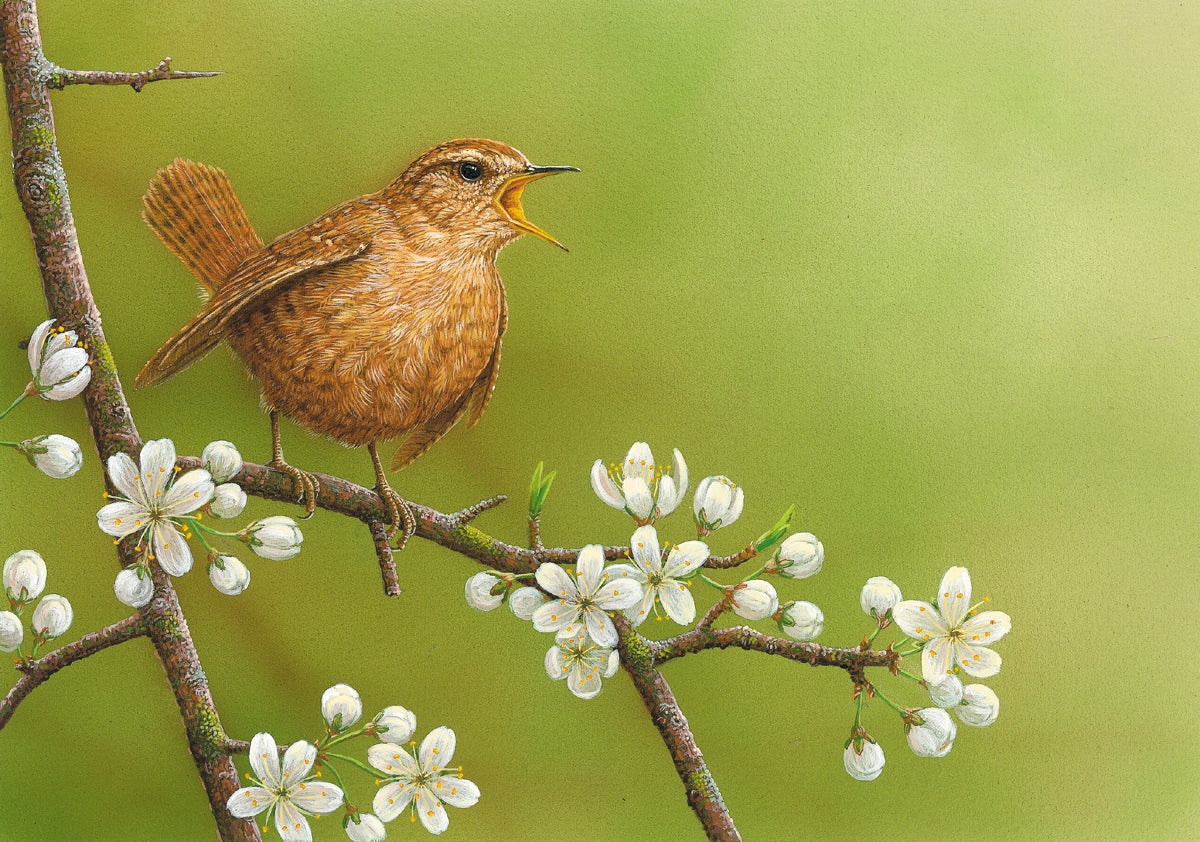The meanings behind different bird songs
I usually sleep with the window open, which means I wake up each morning to a cacophony of bird song. Before I get up, I like to test my knowledge by picking out which species are out there and what they are saying to one another.
 Wren, painted by Robert E Fuller
Wren, painted by Robert E Fuller
Deciphering the dawn chorus
As spring turns to summer this can become quite a challenge. The noise coming from more than 60 different species all singing at once at the tops of their voices gets very confusing. Particularly as some birds will mimic one another. But learning the meaning of bird calls is crucial to understanding and studying wildlife in any depth.
Each bird species has a clearly identifiable song as well as a repertoire of different calls inferring different meanings. You get loud, melodic phrases sung by adult birds announcing their territory or trying to attract a mate. Blackbirds have one of the most tuneful of these harmonies.
Contact calls vs bird alarms
Then you hear more subtle, intimate contact calls made between breeding birds. A tawny male will trill like an ocarina to attract a mate. And then again there are the urgent cries of chicks demanding food from their parents. Some chicks, like long-tailed tits or tree creepers, which tend to form small creches after they have fledged to keep one another warm at night, have developed their own distinct calls to keep in contact.
But the most important set of bird calls to learn is the alarms they shout out to alert one another when there is a predator about. Knowing these means you too can be alert to the presence of other wildlife.

Jenny Wren | Limited Edition Print

Chaffinch on Blackthorn | Limited Edition Print

Yellowhammer | Limited Edition Print
Learning Blackbird calls
Again it is worth mentioning the blackbird. These birds have an entire repertoire of different alarms signifying different types of predators. It is quite astounding how precise each call can be. For instance, a soft, one-toned call means there is a ground predator about, possibly a weasel, stoat or pine marten; whereas a high-pitched, one-toned shrill, means a sparrowhawk in the air above. However if there is a sparrowhawk perched nearby, sitting close to its nest for instance, the blackbird makes an altogether different sound.
This time it is a continuous, chinking, harassing, call. This noise can also mean there is a tawny owl roosting nearby. Other birds, like wrens, chaffinches and greenfinches, often join in with blackbirds to shout down a predator. Together they can make a real din. When I am inside a hide my field of vision is limited and so I rely on these alarm calls. If I hear them I get my camera ready.
Adding lyrics
A traditional way to learn birdsong is to add lyrics to the tune. Yellow hammers have a familiar, nursery rhyme melody, which sounds like: ‘A little bit of butter and nooo cheeeese”.
I recently watched five male red starts chasing a female. To attract her attention, they flashed their russet tails whilst mustering their very best harmonies. These striking birds, which are closely related to robins, migrate in large numbers to the Yorkshire Wolds each summer to breed. But despite their quantities, they are hard to spot. The trick is to listen for their noisy alarm calls and then stand still until they resume their normal activities.
Other birds, like wrens, chaffinches and greenfinches, often join in with blackbirds to shout down a predator. Together they can make a real din. When I am inside a hide my field of vision is limited and so I rely on these alarm calls. If I hear them I get my camera ready.
More of my art inspired by garden birds

Robin on Hawthorn | Limited Edition Print

Long Tailed Tit Perched on a Catkin | Limited Edition Print

Long Tailed Tits on Blackberries | Limited Edition Print

Wren on Cherry Blossom | Limited Edition Print
Tree Sparrows| Limited Edition Print

Bullfinch on Blossom | Limited Edition Print
Long Tailed Tit on Blackthorn | Limited Edition Print

Nuthatch | Limited Edition Print

Blue Tit on Cherry Blossom | Limited Edition Print

Wren on Hook | Limited Edition Print

Blue Tit on Lookout | Limited Edition Print

Long Tailed Tits on Catkins | Limited Edition Print

Robin on Teapot | Limited Edition Print

Long Tailed Tit on Wool | Limited Edition Print

































1 comment
[…] Understanding Bird Song […]